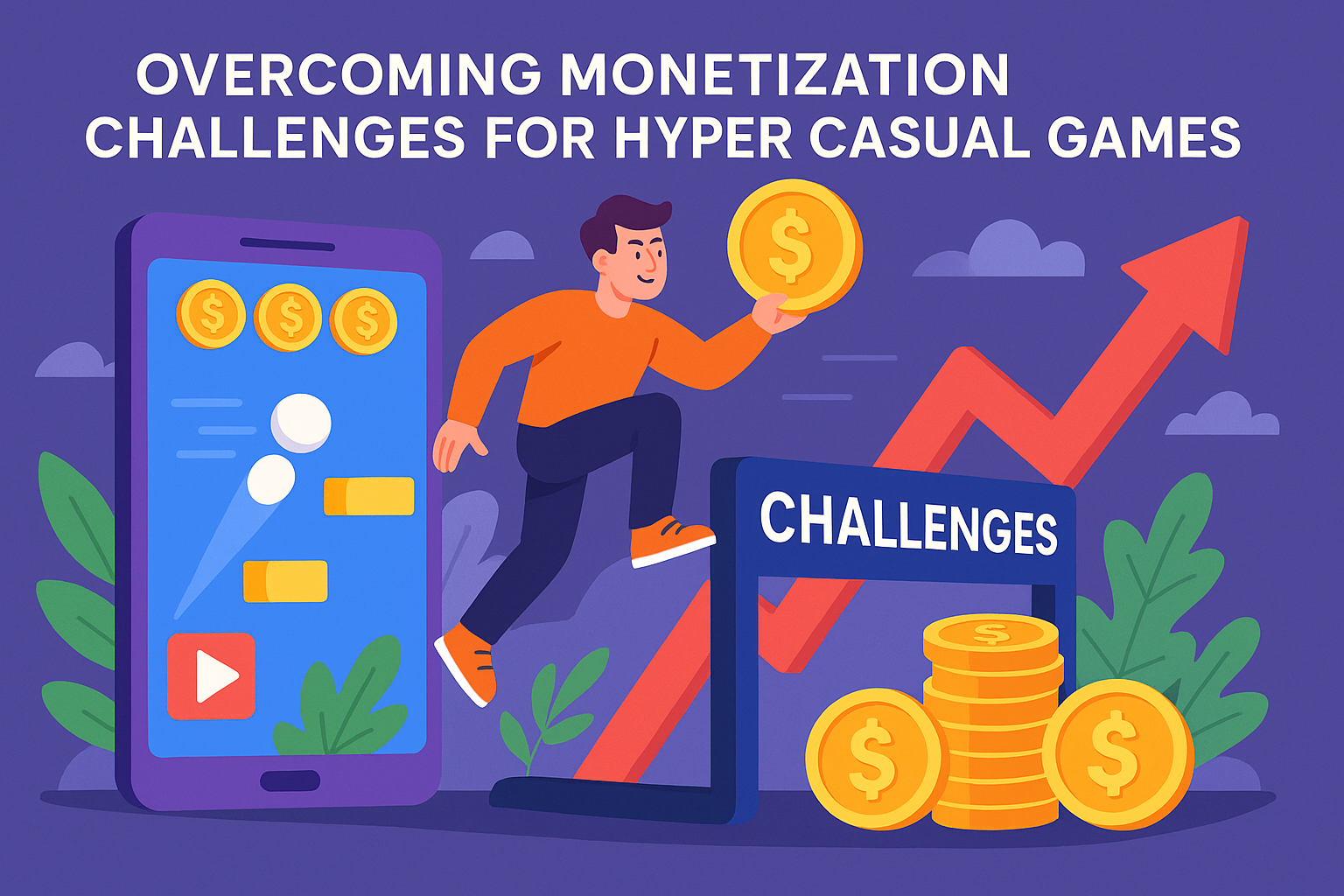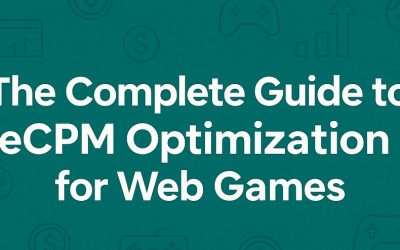Overcoming Monetization Challenges for Hyper Casual Games
Free-to-play hyper-casual games have proven that you can generate substantial revenue without any in-app purchases – if you master advertising-based monetization. To maximize LTV (Lifetime Value) in such games, developers must orchestrate a careful balance of engaging gameplay, strategic ad placements, and continuous optimization.
Maximizing ad-based LTV in hyper-casual games is rewarding but not without hurdles. Developers must navigate several challenges to maintain the balance between monetization and user experience. Here are common challenges and strategies to address them:
Contents
Short Lifespan of Hyper-Casual Players:
Many hyper-casual games see steep drop-offs in engagement – a large chunk of users play once or a few times and never return. On average, only about 10-20% of users are still active by Day 7. This short lifespan limits the window for showing ads, making LTV inherently low per user.
Overcoming it: Focus on retention-driving gameplay and early hooks. While hyper-casual games are meant to be simple, adding light meta-progression or goals can extend how long a user sticks around. For example, introduce new obstacles or increasing challenge over the first 10-20 levels to keep it interesting, or add collectables/skins that unlock as they play (even if via watching ads). Even a modest improvement in retention can yield a lot more ad opportunities. Another tactic is to concentrate monetization in the early sessions (since you might only have that). That means making sure to show at least one or two high-paying ads (like a rewarded or an interstitial) during the first session without driving the user away. It’s a fine line: you want to monetize even those who churn on Day 0, but not in a way that actually causes them to churn. Careful placement (as discussed in best practices) is key. Ultimately, extending the average player’s lifespan – even a little – is one of the most powerful ways to raise LTV in hyper-casual because it’s multiplicative with your ad strategy.
Ad Fatigue and User Frustration:
Seeing the same ad formats repeatedly, or simply too many ads, can lead to “ad fatigue” where users become less responsive or actively annoyed. In hyper-casual games, users often complain if ads feel incessant.
Overcoming it: Variety and moderation. Introduce variety in ad experiences – if possible, leverage different creatives (e.g., don’t always show the exact same ad video every time; use multiple ad networks to get a rotation of ads). Playables and interactive ads can break the monotony of static video ads. Also, as mentioned, dynamic ad frequency helps – e.g., show fewer ads to users who seem less tolerant (short sessions, nearly dropped off), and more to those who seem engaged. The use of rewarded ads as a relief: if a user is getting tired of forced ads, giving them more opportunities to opt in for rewards can make them feel more in control and less negative. For instance, allow a user to self-serve an ad for a reward at their discretion – some hyper-casual games have a button in the home screen like “Free coins” that the user can tap anytime to watch an ad. This way ad-engaged users can do it and others can ignore it. Another approach is meta-game incentives like “watch 5 ads today for a bonus gift” – turning ad watching into a mini challenge. This can paradoxically make ads feel like part of the game rather than an external annoyance, thus reducing fatigue. Also ensure ads are not too disruptive: avoid loud ads if your game is silent, avoid ads that might confuse the user with fake UI elements, etc. The less an ad feels like an ad, the less fatiguing it is.
Balancing Monetization with Retention:
This is an overarching challenge we’ve touched on – push monetization too hard and retention drops; focus only on retention and you might under-monetize.
Overcoming it: Iterative tuning and data analysis are the tools here. It’s rarely a set-and-forget scenario. Continuously A/B test changes on small segments of your audience before rolling out to all users. For example, test a new ad placement on 10% of users and compare their retention and ARPU vs. the 90% control. If it looks good (retention stable, ARPU up), then deploy to all. If retention falls, maybe scrap that idea. Consider implementing event triggers that adjust ad frequency in real-time: e.g., if a user dies several times quickly (frustrated), maybe don’t show an ad on those game-overs to avoid rage-quitting. Conversely, if a user has played 10 levels in one session (clearly enjoying), you might afford to show an extra interstitial here or there. Some developers are exploring AI-driven ad frequency optimization that learns the optimal times for each user (there are tools that claim to adjust interstitial frequency per user to maximize LTV autonomouslyreddit.comreddit.com). But even without AI, you can manually segment users by behavior (for instance, a “high engagement” cohort gets a bit more ads). The main tactic is to always measure the impact on retention for any monetization change. If you inadvertently drop your retention, that can cascade into a smaller active user base, and even though you showed more ads per user, the total ads overall might decline. So treat retention as an equally important metric in monetization decisions, and use controlled experiments to find balance.
Rising User Acquisition (UA) Costs and Privacy Changes:
This is more of a business challenge, but relevant to LTV because if UA gets expensive, you need higher LTV to compensate. In mobile, the cost to acquire users via ads has increased, and targeting is less precise after Apple’s ATT (App Tracking Transparency) which reduced personalized ads. Hyper-casual games historically rely on cheap, broad UA – but that’s gotten tougher.
Overcoming it: One way is indeed maximizing LTV so you can bid more and still be profitable. If your LTV goes from $0.50 to $0.70, that’s a 40% increase in how much you can pay to get a user and break even, giving you an edge in UA campaigns. So all the strategies in this report ultimately feed into surviving in a tougher UA market. Aside from that, hyper-casual publishers are turning to cross-promotion and viral marketing (TikTok trends, etc.) to get installs at lower cost. If you’re a developer focusing on one game, you might consider partnering with a publisher who has that network, because they can drive installs to you more cheaply than you buying users on Facebook, for example. Another angle is multi-platform release: having a web version can capture organic traffic (on game portals or social media instant games) which can then funnel users to mobile, or vice versa. Essentially, broaden your sources of users so you’re not solely reliant on paid UA where costs might be high. If privacy changes mean you can’t target high-value users specifically, the game becomes a volume game – which hyper-casual already is good at. So doubling down on broad appeal and high download potential (through simple concepts and trends) is how many hyper-casual devs offset the UA challenge. It’s less about in-game changes and more about marketing strategy, but intimately tied to LTV: high LTV gives you more breathing room to acquire users under various conditions.
Ad Policy and User Trust Issues:
Another challenge – ensure compliance with platform policies and maintain user trust regarding ads. For instance, Google Play has guidelines on not showing disruptive ads in the first 5 seconds of gameplay, or not using ads that trick users (like fake “Close” buttons). Violating these can get your game flagged or removed. Also, showing ads inappropriate for certain audiences can cause problems (imagine a hyper-casual game popular with kids accidentally showing a mature ad).
Overcoming it: Stay informed on ad policy updates for App Store/Play Store. Design your ad logic to comply (e.g., implement that initial delay, and avoid sudden full-screen ads without user action if against guidelines). Use content filters in ad networks for age-appropriate ads if needed. On the user trust side, transparency helps: if your game is feeding personal data to ad networks, you might need to show consent dialogues (especially in regions like EU with GDPR). Though that’s more on initial user experience, it can affect opt-in to tracking which affects personalized ads revenue. It’s a balancing act: asking users to opt in to tracking can increase ad revenue quality, but some won’t and you have to respect that. At least hyper-casual games have reported relatively decent ATT opt-in rates perhaps because users don’t strongly object or understand it in this context (some reports noted hyper-casual players clicking “Allow” more often, possibly to get rid of the prompt quickly). The best practice is to comply with privacy needs and perhaps explain how ads support the free game. A short note like “We use data to show better ads to keep this game free – please enable if OK” might improve opt-in. Ensure your game’s reputation isn’t marred by any feeling of “ad scamminess.” Over time, if players know your game as “the one with endless ads,” word of mouth suffers. But if it’s “yeah it has ads, but it’s fun and fair,” you’ll retain a good audience.
Platform Differences (Mobile vs Web):
If you’re deploying on web as well, you have some unique challenges: ad blockers, diverse screen sizes, no standardized ad ID for user targeting, etc. On mobile, you have to deal with iOS vs Android differences (like iOS users opting out of tracking more, meaning lower eCPMs due to less targeting, or different fill rates in different countries).
Overcoming it: For web, detect ad blockers and consider prompting politely (“Our games are free thanks to ads. Please consider disabling your ad blocker.”). Some fraction of users might whitelist. Alternatively, offer a paid ad-free site subscription (some game portals do this). Also, optimize ad formats for web: maybe use more banner and less “pop-up” interstitial if pop-ups get blocked. Use known web game ad networks that have workarounds for these (like they might do server-side ad insertion). On mobile, segment your analytics by platform – you might find your Android LTV vs iOS LTV are different. If iOS LTV dropped post-ATT, maybe focus UA on Android or other channels like Android web-playable ads. Or work on improving iOS retention to compensate for lower ad yield per user. Essentially, tailor your strategy per platform: web players might have shorter sessions but maybe return more frequently (since no install needed), so maybe more frequent but shorter ads work there. Mobile players might endure longer ads but fewer sessions if they uninstall quick. Recognize these patterns via metrics and adapt (you could even have slightly different ad settings in the web version vs the mobile version if needed).
In summary, while challenges in ad-based monetization exist, the key is to remain flexible and player-focused. The developers who succeed treat monetization as an extension of game design: they iterate, they listen to player behavior/feedback, and they adjust to external changes (UA costs, policies) with creative solutions. Hyper-casual games operate on thin margins per user, so it’s about finding efficiencies and improvements wherever possible – turning each challenge into an opportunity to differentiate your game as better monetized but also better for players.
AppLixir Monetization Platform
Crucially, maximizing ad LTV lets a game scale up. Higher LTV means you can justify spending more on acquiring users, which can propel the game to the top of the charts (a virtuous cycle seen in many hyper-casual hits)supersonic.com. In a competitive market, the studios that finely tune their ad monetization are the ones able to profitably reach millions of players.
Looking ahead, as technologies evolve, we might see even more sophisticated ways to balance ads and gameplay – from AI-driven personalized ad timing to new ad formats like AR/VR ads that could engage users in novel ways. But no matter the trend, the foundation will remain: a great hyper-casual game experience first, and a monetization strategy that complements it second. By following the strategies and best practices discussed – focusing on rewarding ad experiences, optimal ad frequency, vigilant metric tracking, and proactive challenge mitigation – developers can significantly increase the lifetime value of their hyper-casual game. The end result is a win-win: players enjoy a free game with well-integrated ads, and developers/publishers reap the rewards through higher ad revenue over the game’s lifetime, all achieved without relying on in-app purchases. In the hyper-casual world, fun and profitability can indeed coexist when advertising is leveraged thoughtfully and strategically – delivering value to players and value back to developers in equal measure.



